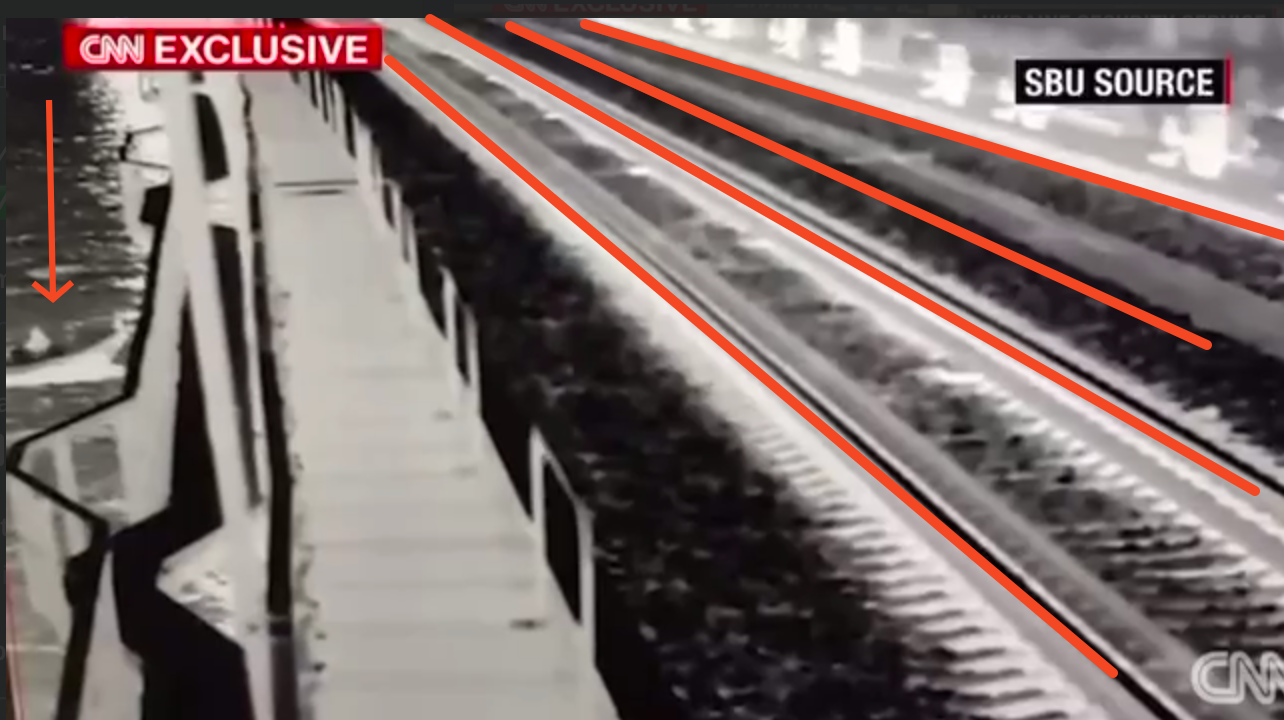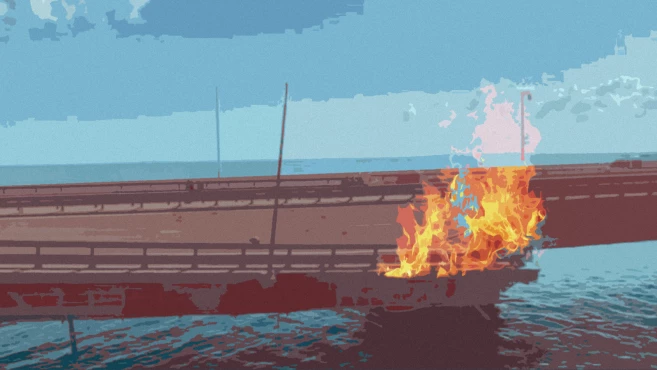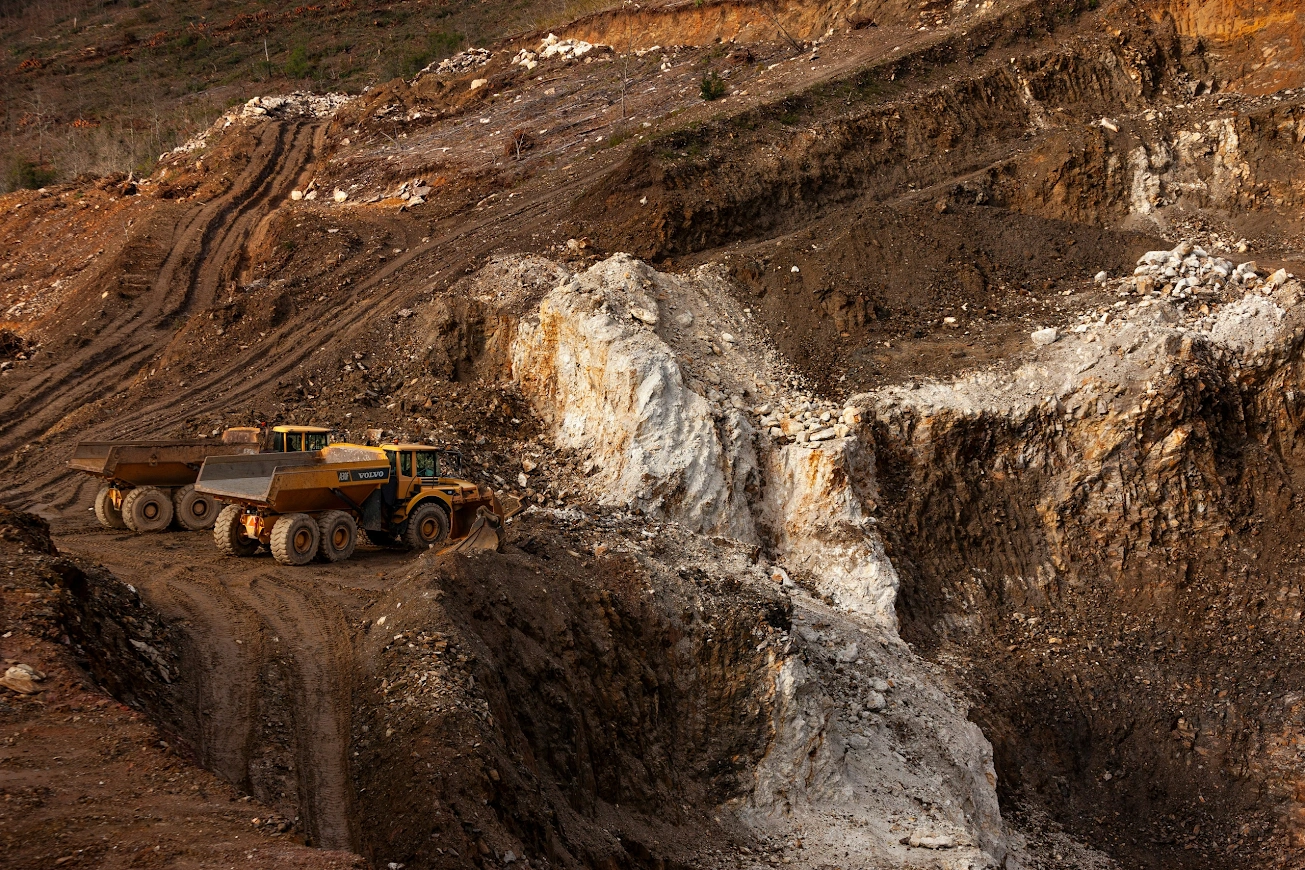The unlawfully built Crimean bridge made a resounding statement about itself on July 17. The news was abuzz with information about a 'bottleneck' on the crossing. They announced two explosions: the first affecting the car lane, the other — the railway track.
As per their usual tactic, Russian propagandists have stated that 'nothing occurred,' and the bridge allegedly resumed its regular function the next day. But all who travel on it are prohibited from capturing the damages and effects, and heavy cargo trains are still not transiting. Concurrently, the previously non-functioning ferry service has been reinstated. OSINT agency Molfar's analysts have explored the happenings at the Crimean bridge. Find more details in this article.
Railways Under Attack — Why Is It Important?
The railway connection between the occupied Crimea and Russia enabled the Russian army to move heavy equipment swiftly. It is important to emphasize that the Russian military heavily depended on the railway network. They regularly dispatched trains carrying heavy machinery to Crimea as part of their preparations for a potential large-scale invasion. For instance, in March 2021, videos showed tanks being transported on the railway segment of the Crimean bridge.
Since these explosions damaged the bridge's road and railway sections, it can be inferred that it will considerably hinder the Russians' delivery of heavy equipment to Crimea.
The Russian engineers reportedly issued an official diagnosis of the bridge on the day following the explosions. According to VK publications (1, 2) from the 'official account' of the Crimean bridge, the diagnosis allegedly confirms the reliability of the structure. However, the external intelligence group tZEinform later claimed that the report they received from St. Petersburg is said to "contain strong language". Initially, they announced that the repairs would be completed by November 1 this year. However, the repair deadline was later extended to December 31.
According to videos and statements from Russian media (1, 2, 3), electric trains are running without delays. Tickets can be purchased from July 21, 2023. From July 20, tickets for comfortable trains have also been added. However, this information explicitly concerns passenger trains. Freight trains, on the other hand, are considerably heavier.
Usually, the weight of a passenger car weighs 30 to 60 tons, depending on the model and construction features. A second-class passenger car may weigh approximately 30 - 40 tons, while a first-class or sleeping car can weigh between 45-60 tons. A tanker car, depending on the type of fuel and its volume, can weigh around 100 tons.
Still, according to information from a source related to the construction progress, the column has cracks. Therefore, the movement of freight trains across the bridge is no longer possible.
UPD: The Security Service of Ukraine (SBU) has released footage of a July strike on the Crimean Bridge, which was illegally constructed by Russia. In the video, at least one surface drone, "Sea Baby", can be seen hitting a pillar. CNN journalists have noted that the strike was specifically on the railway section, as evidenced by this screenshot from the video.

In the next photo, you can see the aftermath of that strike:
In the video posted by a train passenger (1, 2), one can see that the railway section of the bridge has suffered damage. Recordings from passengers with voice comments indicate ongoing restoration of the damages: “Here is the restoration, the truss is hanging”.
“The entire bridge is hanging”. What happened on the road part of the crossing?
The Crimean bridge was illegally constructed in 2018. It consists of two main parts: a four-lane roadway for automobiles and a railway bridge with two tracks.
For the first time since the full-scale Russian invasion, the Crimean bridge suffered damages on October 8, 2022. The roadway part of the bridge collapsed. At that time, the occupiers tried to conceal the extent of the damage. Still, numerous photos and videos quickly spread across the internet.
On the morning of July 17, 2023, due to two explosions, both parts of the structure - the railway and the roadway – were damaged.
On July 17, the pro-Russian media reported that two explosions occurred on the bridge at 3:05 and 3:20. Sergey Aksyonov, the representative of the Russian occupation authorities in Crimea, stated that the explosions took place near the 145th support of the bridge. This location holds symbolic significance, as the license is situated on the island of Tuzla, which marks the border of Ukraine's territorial waters. Consequently, according to their perspective, this is considered a legitimate target for the strikes by the Ukrainian Armed Forces.
One part of the bridge's structure has been destroyed. At the same time, another has shifted by a meter due to the explosion. The roadways are covered with cracks, significantly damaging the entire bridge structure. The 145th span suffered the most extensive damage, partially destroying its supporting structure.
In this video, it is mentioned that the explosion came from below, from the sea level. Drones likely detonated beneath the bridge.
In this VK video, the driver narrates his experience on the road: 'This part of the bridge is now higher; workers have been adding materials, and the bridge seems to be falling apart.' At one point, the car jolts as if hitting an obstacle, and the driver remarks, “Here, the road becomes elevated too; the entire span feels suspended.”
Users on Telegram chats are discussing serious damage to the Crimean bridge's highway. In conversations about the explosions, various theories are being expressed. On the Russian blog platform "Yandex Zen," one user commented on a blog post claiming that all four highway lanes were damaged, suggesting a powerful explosion might have occurred.
A user claiming to have been among the bridge construction workers writes, 'All of this is a dirty story: for such damages to occur, it would require either a direct strike from above (like a rocket, for example) or from below, but underneath the road deck, on the beam.
Interesting information from the Telegram chat 'Situation on the Kerch Bridge' reveals restrictions for motorists. According to the comments, the maximum weight for vehicles allowed on the bridge is 3.5 tons.
We can infer from these facts that weight restrictions for vehicles raise concerns about the safety of transportation on this bridge.
Moreover, the logistics set up by the occupiers through the bridge are under scrutiny. Secondly, these substantial damages might necessitate a large-scale reconstruction, requiring significant funds and time.
Later, Marat Khusnullin, the Russian official in charge of housing and public utilities, stated that they intended to build a temporary bridge for repair works. (1, 2) The quick bridge construction is scheduled to take two months.
Ferry passage and the Crimean bridge
During the bridge repair by the occupiers, they have the alternative of using the ferry crossing. Situated in the Kerch Strait, which separates occupied Crimea from the Russian Taman Peninsula, the ferry crossing operates several vessels for transporting passengers, vehicles, buses, and other cargo. The usual travel time for the ferry crossing is around 30 minutes, although it is subject to weather conditions.
The ferry crossing was closed until July 16th. However, the morning after the explosion, the occupiers announced its resumption. At that time, there were 2 ferries and one passenger catamaran in operation: the ferry “Kerchinsky-2”, with a capacity for 61 passengers and 15 'Gazelle' type vehicles; the passenger catamaran “Diana”, capable of accommodating 150 people; and the ferry “Lavrentiy”, designed for 136 passengers and 15 large vehicles.
On July 19, the Kerch ferry crossing completed 16.5 round trips, carrying 2108 passengers, 103 railway wagons, and 593 vehicles. Russian propaganda channels claimed that the ferry crossing is operating exceptionally well and announced plans to expand it with up to 8 ferries. 'Vesti Krym' (1, 2) reported that there are currently 5 ferries in operation, while 'Krim24' (1, 2) mentioned 3.
Meanwhile, in social media comments, Russians who used the ferry crossing are expressed their dissatisfaction with its operation. A video shared by VK user Elvira Yakutkina from the ferry station shows passengers waiting for the ferry for 5 hours. She commented on her post from the Crimean bridge, published on July 20, stating, 'This is the real situation.'
Analysis of satellite images
On July 17, 2023, the bridge over the Kerch Strait was not operational – all movement on it came to a complete halt. These satellite images attest to that.
The following two images show the state of the bridge five days later. The damage to the road section is evident—part of the road is closed. There is also damage to the railway section of the bridge. As of 18:20, there were no trains observed on the railway. Near the damaged area, a group of cars can be seen, possibly repair crews. However, it is also probable that a traffic jam has formed at the damaged site, and traffic is moving slowly.
What happened there? A timeline of events
On July 17, 2023, 'disturbing' news emerged about a 'bottleneck' at the Crimean bridge. The first explosion occurred at 3:05 AM near the bridge's vehicular section (1, 2). Around thirty minutes later, from 3:20 to 3:40, a second explosion happened under the bridge's railway part. It's said that the second blast led to injuries in a car with Russian civilians. A man and woman died, and their daughter was wounded and taken to the hospital.
This is a photo of the car crossing the bridge at the moment of the explosion. Part of the concrete structure fell onto the vehicle. The engine was pushed into the passenger and driver's side.
According to a post in the 'Mash room' Telegram channel, 'the support pillar was not damaged; only the bridge's span was affected.
On the following day, at approximately 01:00 AM, the Russians partially reopened traffic on the bridge. Once again, 'for safety reasons,' every vehicle was checked, and drivers and passengers were provided with particular guidelines while capturing photos or videos of any damaged sections of the bridge was forbidden. The railway traffic restored later, at 9:00 AM.
These satellite images show objects rapidly moving from Snake Island to the Crimean bridge. OSINT analyst MT Anderson suggests on his Twitter that they might be military drones. The path and motion of the drones are "intriguing, given the recent events," as stated by the analyst in his findings. As per an article in iz.ru media, two out of the four drones were possibly deployed from civilian vessels. These drones were submersible, thus evading detection by security.
UPD: As of August 16th, it turns out that the theory about underwater drones was incorrect. According to the video published by the CNN, the strike was made by a surface drone.
The Telegram channel Mash published a video of the damaged drone allegedly attacking the bridge. The publication's authors also noted that jet skis were used to distract the security forces. Such a strategy allowed the real combat drones to break through to the bridge's support. However, another Telegram channel refuted this version. The mentioned video was filmed a day before the events on the Crimean bridge.
Summary
Two explosions occurred on the illegally constructed Crimean bridge by the Russians. Both road and railway traffic on the bridge were halted. According to Russian media reports, maritime drones caused the explosions.
Later, on Telegram channels, it was reported that "the bridge support was not affected; only the span was damaged". Nevertheless, there are several important details that should be noted. The damage to the bridge may be more severe than what official sources claim. Similarly, they downplayed the impact's consequences of the first attack - we discussed this in our analysis of the previous episode.
The repair process will require a significant amount of Russian funds and time. It is worth noting that the freight traffic through the bridge is now significantly restricted, affecting the transportation of heavy military equipment. This could have serious strategic implications for the Russian military presence in the region.
An unpleasant surprise awaits Russian vacationers - they are now forced to stand in long queues or choose an alternative route through the occupied territories of the South. The need for more quick and comfortable access to Crimea will inevitably impact the tourist flow and, consequently, the economy of the occupied peninsula.




